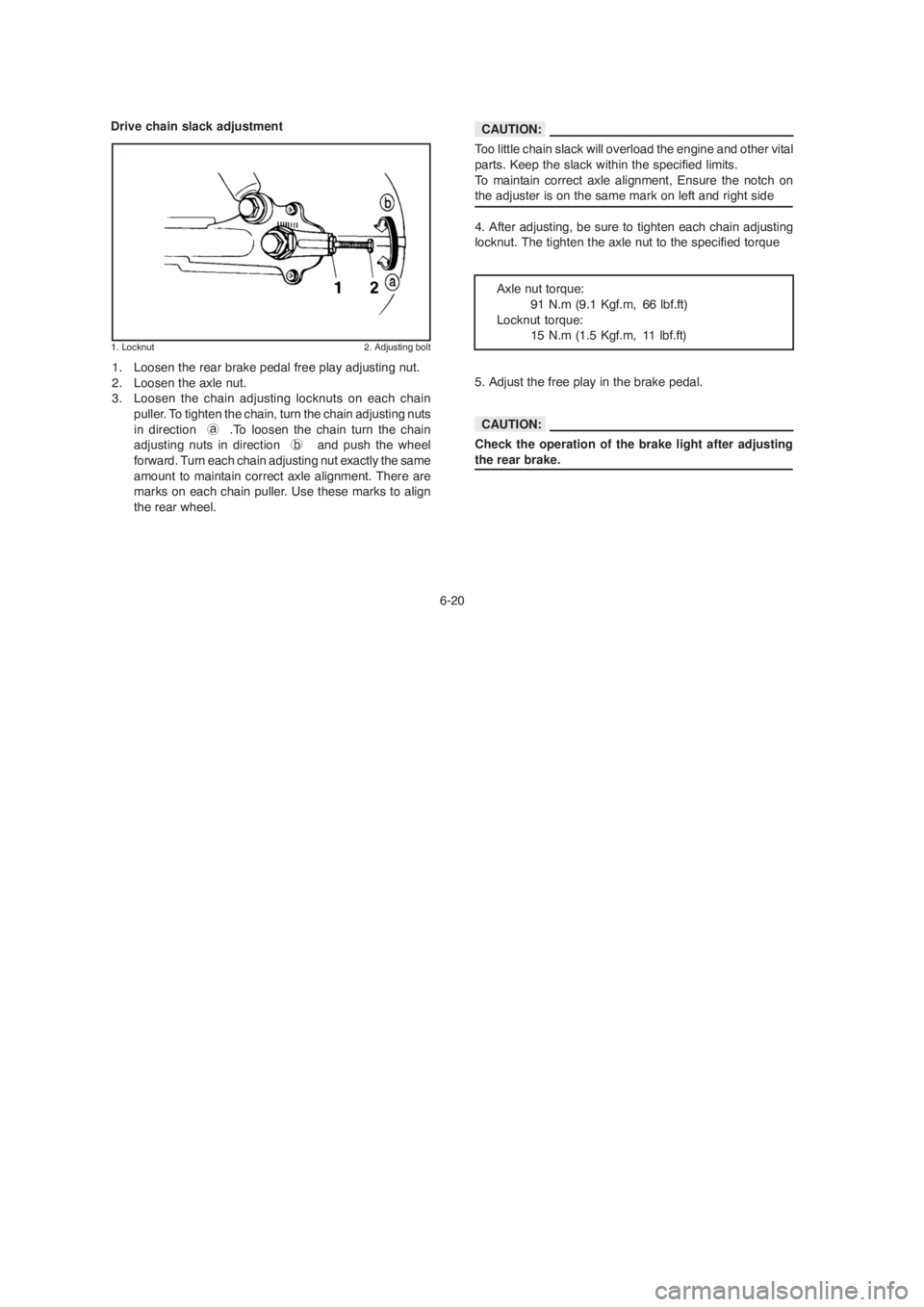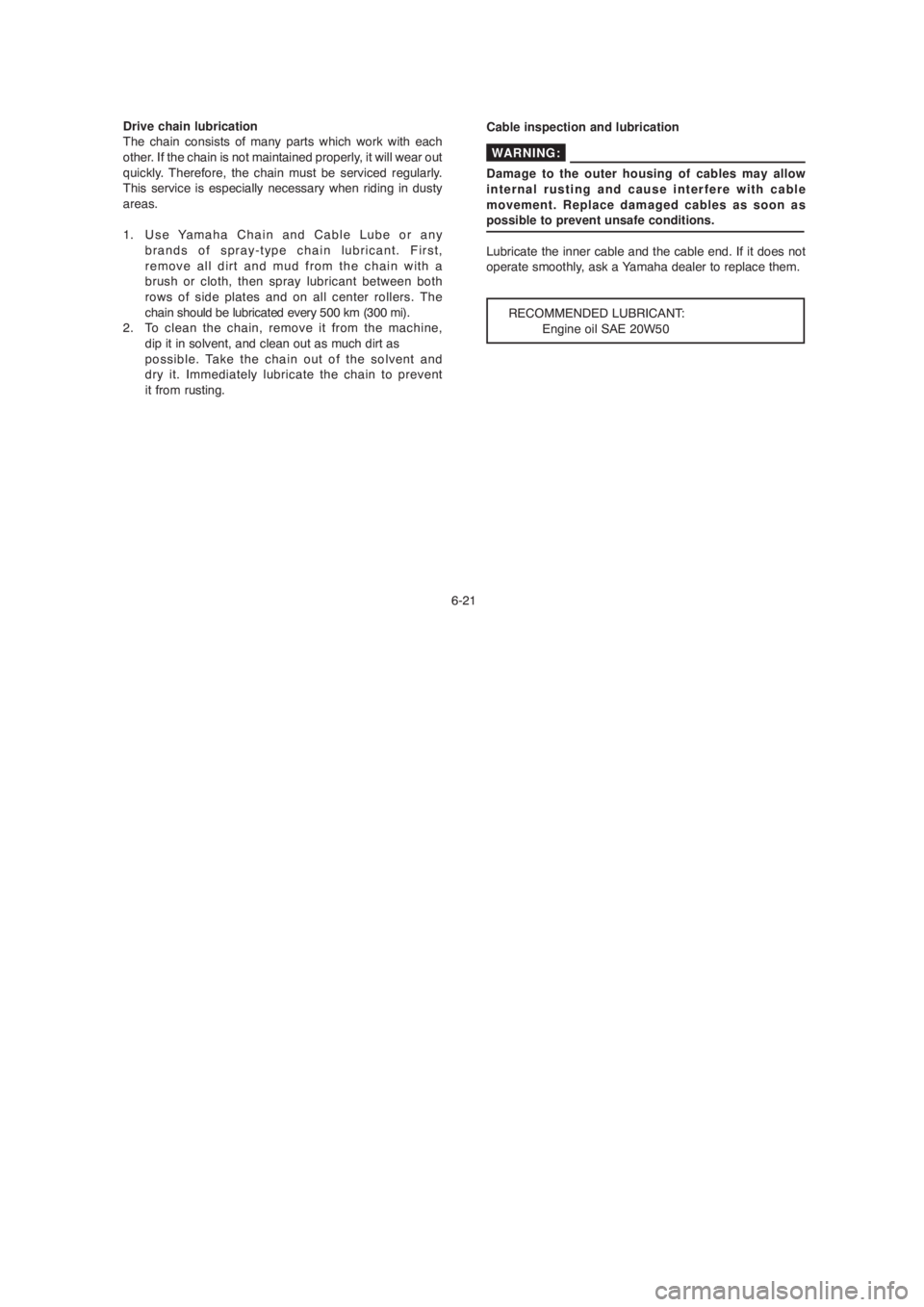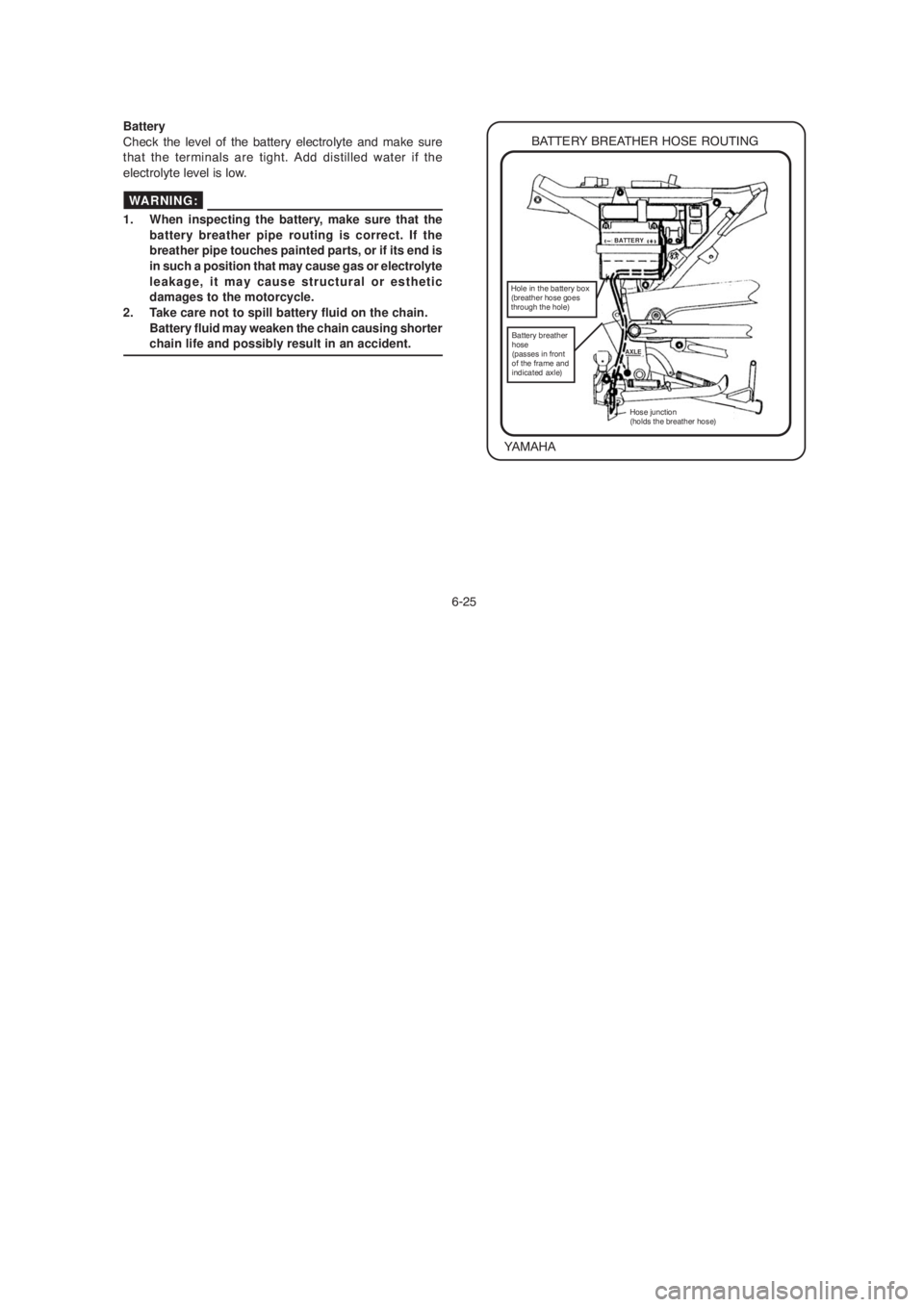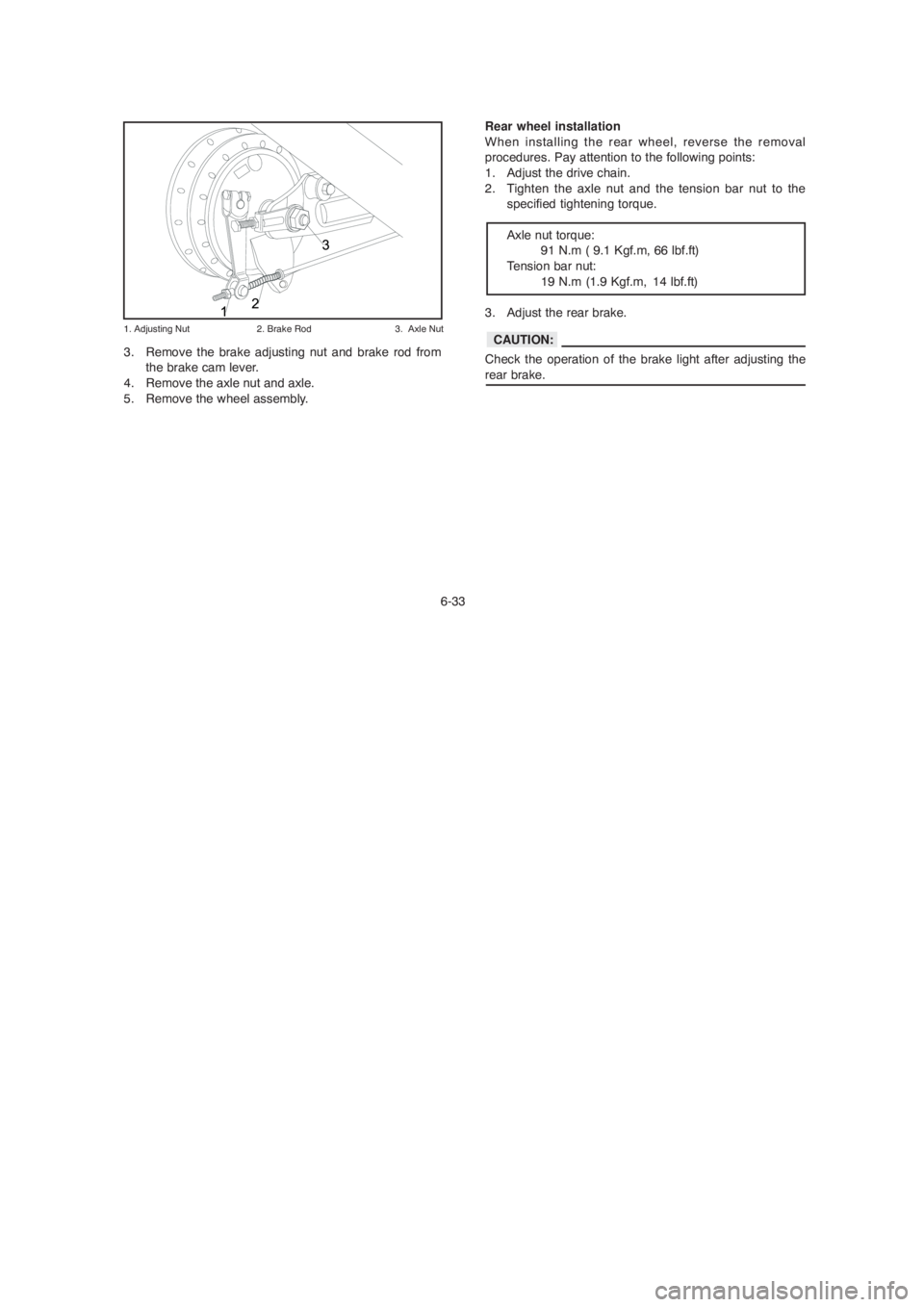2004 YAMAHA YBR125 Chain
[x] Cancel search: ChainPage 12 of 83

PERIODIC MAINTENANCE AND MINOR REPAIRS..... 6-1
Tool kit..................................................................... 6-2
PERIODIC MAINTENANCE/LUBRICATION......... 6-3
Torque specifications............................................. 6-5
Engine oil................................................................ 6-6
Oil pressure............................................................ 6-9
Air filter.................................................................6-10
Carburetor adjustment.........................................6-12
Valve clearance adjustment.................................6-12
Idle speed adjustment..........................................6-13
Throttle cable adjustment....................................6-14
Spark plug inspection...........................................6-15
Front brake adjustment........................................6-16
Checking the brake shoes ...................................6-16
Rear brake adjustment.........................................6-17
Brake light switch adjustment ..............................6-18
Clutch adjustment................................................ 6-18
Drive chain slack check.......................................6-19
Drive chain slack adjustment...............................6-20
Drive chain lubrication..........................................6-21
Cable inspection and lubrication.......................... 6-21
Throttle cable and grip lubrication .......................6-22
Brake and shift pedals .........................................6-22
Brake and clutch levers .......................................6-22
Sidestand.............................................................6-22
Front fork inspection............................................6-23Steering inspection.............................................. 6-24
Wheel bearings.................................................... 6-24
Battery.................................................................. 6-25
Replenishing the battery fluid .............................. 6-26
Storage the battery.............................................. 6-27
Fuse replacement................................................ 6-27
Headlight bulb replacement................................. 6-28
Turn signal bulb replacement.............................. 6-30
Taillight bulb replacement.................................... 6-30
Front wheel removal............................................. 6-31
Front wheel installation........................................ 6-32
Rear wheel removal............................................. 6-32
Rear wheel installation......................................... 6-33
Troubleshooting.................................................... 6-34
Troubleshooting chart.......................................... 6-35
CLEANING AND STORAGE....................................... 7-1
CLEANING............................................................. 7-1
STORAGE.............................................................. 7-2
SPECIFICATIONS ........................................................ 8-1
XII
CONTENTS
DESCRIPTION............................................................. 1-1
MACHINE IDENTIFICATION....................................... 2-1
Vehicle identikfication number ............................... 2-1
Engine serial number............................................ 2-1
CONTROL FUNCTIONS.............................................. 3-1
Main switch ............................................................ 3-1
Indicator lights ........................................................ 3-2
Speedometer..........................................................3-3
Fuel gauge............................................................. 3-3
Handlebar switches over left .................................. 3-4
Handlebar switches over right.............................. 3-5
Clutch lever............................................................ 3-6
Shift pedal............................................................. 3-6
Front brake lever................................................... 3-7
Rear brake pedal................................................... 3-7
Fuel tank cap......................................................... 3-8
Fuel cock............................................................... 3-9
Starter lever......................................................... 3-10
Kick starter .......................................................... 3-10
Steering lock....................................................... 3-11
Seat......................................................................3-12
Side covers......................................................... 3-13
Rear shock absorber adjustment ....................... 3-14
XIPRE-OPERATION CHECKS........................................ 4-1
Engine oil................................................................ 4-3
Tires........................................................................4-3
Fitting/Fasteners....................................................4-6
Switches................................................................ 4-6
Wheels ......................................................... 4-6
Fuel ........................................................... 4-7
OPERATION AND IMPORTANT RIDING POINTS....... 5-1
Starting a cold engine........................................... 5-2
Starting a warm engine .......................................... 5-2
Warming up the engine .......................................... 5-2
Shifting ................................................................... 5-3
Tips for reduccing fuel consumption...................... 5-4
Engine Break-in...................................................... 5-4
Parking ................................................................... 5-5
Page 29 of 83

PRE-OPERATION CHECKS
Before using this motorcycle, check the following points:
ITEM ROUTINE
PAGE
Check operation, condition and free play.
Adjust if necessary
Clutch
Throttle grip / cableCheck for smooth operation.
Lubricate / Adjust if necessary
Check oil level / add oil as necessary
Engine oil
Drive chainCheck chain slack and condition. Lubricate if necessary
Adjust if necessary.
Air filter
Control and meter cableCheck tire pressure, wear, damage and spoke tightness
Check for smooth operation.
Lubricate if necessary6-16 ~ 6-18
6-14 , 6-22
4-3 , 6-6 , 6-9
6-19 ~ 6-21
6-10 ~ 6-11
4-3 ~ 4-6 , 6-31~ 6-33
6-21 Check operation, condition and free play.
Adjust if necessary
Wheels / Tires
Clean and oil it frequently.6-18 Brakes
4-1
PRE-OPERATION CHECKS
Before using this motorcycle, check the following points:
ITEM ROUTINE
PAGE
Check operation, condition and free play.
Adjust if necessary
Clutch
Throttle grip / cableCheck for smooth operation.
Lubricate / Adjust if necessary
Check oil level / add oil as necessary
Engine oil
Drive chainCheck chain slack and condition. Lubricate if necessary
Adjust if necessary.
Air filter
Control and meter cableCheck tire pressure, wear, damage and spoke tightness
Check for smooth operation.
Lubricate if necessary6-16 ~ 6-18
6-14 , 6-22
4-3 , 6-6 , 6-9
6-19 ~ 6-21
6-10 ~ 6-11
4-3 ~ 4-6 , 6-31~ 6-33
6-21 Check operation, condition and free play.
Adjust if necessary
Wheels / Tires
Clean and oil it frequently.6-18 Brakes
4-1
Page 44 of 83

6-4 *
**
***: It is recommended that these items be serviced by a Yamaha dealer.
: Molybdenum disulfide grease.
: Lithium soap based grease.
ITEM
Front forks*
Centerstand and
sidestand*
Control cables: throttle /
clutch / front brakeRear shock absorber*
Drive chain
Fittings / fastenersCheck operation / oil leakage.
Check operation, looseness.
Adujst / Check operation
Lubricate every 12,000 Km. Check chain slack / lubricate, adjust if necessary.
Check and looseness.REMARKS1,000KM
Lights and flashers
Nuts and bolts
Motorcycle AspectCheck operation.
Check tighten.
General Check
EVERY
3,000KM
OR EVERY3,000KM
Check operation / oil leakage.
Every 500 Km
6-4 *
**
***: It is recommended that these items be serviced by a Yamaha dealer.
: Molybdenum disulfide grease.
: Lithium soap based grease.
ITEM
Front forks*
Centerstand and
sidestand*
Control cables: throttle /
clutch / front brakeRear shock absorber*
Drive chain
Fittings / fastenersCheck operation / oil leakage.
Check operation, looseness.
Adujst / Check operation
Lubricate every 12,000 Km. Check chain slack / lubricate, adjust if necessary.
Check and looseness.REMARKS1,000KM
Lights and flashers
Nuts and bolts
Motorcycle AspectCheck operation.
Check tighten.
General Check
EVERY
3,000KM
OR EVERY3,000KM
Check operation / oil leakage.
Every 500 Km
Page 59 of 83

6-19
Drive chain slack check NOTE:
Spin the wheel several times and find the tightest position
of the chain. Check and/or adjust the chain slack while it is
in this tightest position.
To check the chain slack the motorcycle must be held
straight up with both wheels on the ground and without rider.
Check the slack at the position shown in the illustration.
Normal slack is approximately 20 ~ 30 mm ( 0.8 ~ 1.2 in). If
the slack exceeds 30 mm ( 1.2 in), adjust.
a. 20 ~ 30 mm (0.8 ~ 1.2 in)
6-19
Drive chain slack checkNOTE:
Spin the wheel several times and find the tightest position
of the chain. Check and/or adjust the chain slack while it is
in this tightest position.
To check the chain slack the motorcycle must be held
straight up with both wheels on the ground and without rider.
Check the slack at the position shown in the illustration.
Normal slack is approximately 20 ~ 30 mm ( 0.8 ~ 1.2 in). If
the slack exceeds 30 mm ( 1.2 in), adjust.
a. 20 ~ 30 mm (0.8 ~ 1.2 in)
Page 60 of 83

6-20
Drive chain slack adjustment
1. Locknut 2. Adjusting bolt
1. Loosen the rear brake pedal free play adjusting nut.
2. Loosen the axle nut.
3. Loosen the chain adjusting locknuts on each chain
puller. To tighten the chain, turn the chain adjusting nuts
in direction a .To loosen the chain turn the chain
adjusting nuts in direction b and push the wheel
forward. Turn each chain adjusting nut exactly the same
amount to maintain correct axle alignment. There are
marks on each chain puller. Use these marks to align
the rear wheel.Too little chain slack will overload the engine and other vital
parts. Keep the slack within the specified limits.
To maintain correct axle alignment, Ensure the notch on
the adjuster is on the same mark on left and right side
4. After adjusting, be sure to tighten each chain adjusting
locknut. The tighten the axle nut to the specified torque
Axle nut torque:
91 N.m (9.1 Kgf.m, 66 lbf.ft)
Locknut torque:
15 N.m (1.5 Kgf.m, 11 lbf.ft)
5. Adjust the free play in the brake pedal.
Check the operation of the brake light after adjusting
the rear brake.
CAUTION:
CAUTION:
6-20
Drive chain slack adjustment
1. Locknut 2. Adjusting bolt
1. Loosen the rear brake pedal free play adjusting nut.
2. Loosen the axle nut.
3. Loosen the chain adjusting locknuts on each chain
puller. To tighten the chain, turn the chain adjusting nuts
in direction a .To loosen the chain turn the chain
adjusting nuts in direction b and push the wheel
forward. Turn each chain adjusting nut exactly the same
amount to maintain correct axle alignment. There are
marks on each chain puller. Use these marks to align
the rear wheel.Too little chain slack will overload the engine and other vital
parts. Keep the slack within the specified limits.
To maintain correct axle alignment, Ensure the notch on
the adjuster is on the same mark on left and right side
4. After adjusting, be sure to tighten each chain adjusting
locknut. The tighten the axle nut to the specified torque
Axle nut torque:
91 N.m (9.1 Kgf.m, 66 lbf.ft)
Locknut torque:
15 N.m (1.5 Kgf.m, 11 lbf.ft)
5. Adjust the free play in the brake pedal.
Check the operation of the brake light after adjusting
the rear brake.
CAUTION:
CAUTION:
Page 61 of 83

6-21 Drive chain lubrication
The chain consists of many parts which work with each
other. If the chain is not maintained properly, it will wear out
quickly. Therefore, the chain must be serviced regularly.
This service is especially necessary when riding in dusty
areas.
1. Use Yamaha Chain and Cable Lube or any
brands of spray-type chain lubricant. First,
remove all dirt and mud from the chain with a
brush or cloth, then spray lubricant between both
rows of side plates and on all center rollers. The
chain should be lubricated every 500 km (300 mi).
2. To clean the chain, remove it from the machine,
dip it in solvent, and clean out as much dirt as
possible. Take the chain out of the solvent and
dry it. Immediately lubricate the chain to prevent
it from rusting.Cable inspection and lubrication
Damage to the outer housing of cables may allow
internal rusting and cause interfere with cable
movement. Replace damaged cables as soon as
possible to prevent unsafe conditions.
Lubricate the inner cable and the cable end. If it does not
operate smoothly, ask a Yamaha dealer to replace them.
RECOMMENDED LUBRICANT:
Engine oil SAE 20W50
WARNING:
6-21 Drive chain lubrication
The chain consists of many parts which work with each
other. If the chain is not maintained properly, it will wear out
quickly. Therefore, the chain must be serviced regularly.
This service is especially necessary when riding in dusty
areas.
1. Use Yamaha Chain and Cable Lube or any
brands of spray-type chain lubricant. First,
remove all dirt and mud from the chain with a
brush or cloth, then spray lubricant between both
rows of side plates and on all center rollers. The
chain should be lubricated every 500 km (300 mi).
2. To clean the chain, remove it from the machine,
dip it in solvent, and clean out as much dirt as
possible. Take the chain out of the solvent and
dry it. Immediately lubricate the chain to prevent
it from rusting.Cable inspection and lubrication
Damage to the outer housing of cables may allow
internal rusting and cause interfere with cable
movement. Replace damaged cables as soon as
possible to prevent unsafe conditions.
Lubricate the inner cable and the cable end. If it does not
operate smoothly, ask a Yamaha dealer to replace them.
RECOMMENDED LUBRICANT:
Engine oil SAE 20W50
WARNING:
Page 65 of 83

6-25
BATTERY BREATHER HOSE ROUTING
YAMAHA Battery
Check the level of the battery electrolyte and make sure
that the terminals are tight. Add distilled water if the
electrolyte level is low.
1. When inspecting the battery, make sure that the
battery breather pipe routing is correct. If the
breather pipe touches painted parts, or if its end is
in such a position that may cause gas or electrolyte
leakage, it may cause structural or esthetic
damages to the motorcycle.
2. Take care not to spill battery fluid on the chain.
Battery fluid may weaken the chain causing shorter
chain life and possibly result in an accident.
WARNING:
BATTERY
AXLE
Hole in the battery box
(breather hose goes
through the hole)
Battery breather
hose
(passes in front
of the frame and
indicated axle)
Hose junction
(holds the breather hose)
6-25
BATTERY BREATHER HOSE ROUTING
YAMAHA Battery
Check the level of the battery electrolyte and make sure
that the terminals are tight. Add distilled water if the
electrolyte level is low.
1. When inspecting the battery, make sure that the
battery breather pipe routing is correct. If the
breather pipe touches painted parts, or if its end is
in such a position that may cause gas or electrolyte
leakage, it may cause structural or esthetic
damages to the motorcycle.
2. Take care not to spill battery fluid on the chain.
Battery fluid may weaken the chain causing shorter
chain life and possibly result in an accident.
WARNING:
BATTERY
AXLE
Hole in the battery box
(breather hose goes
through the hole)
Battery breather
hose
(passes in front
of the frame and
indicated axle)
Hose junction
(holds the breather hose)
Page 73 of 83

6-33
3. Remove the brake adjusting nut and brake rod from
the brake cam lever.
4. Remove the axle nut and axle.
5. Remove the wheel assembly.
1. Adjusting Nut 2. Brake Rod 3. Axle Nut
Rear wheel installation
When installing the rear wheel, reverse the removal
procedures. Pay attention to the following points:
1. Adjust the drive chain.
2. Tighten the axle nut and the tension bar nut to the
specified tightening torque.
Axle nut torque:
91 N.m ( 9.1 Kgf.m, 66 lbf.ft)
Tension bar nut:
19 N.m (1.9 Kgf.m, 14 lbf.ft)
3. Adjust the rear brake.
Check the operation of the brake light after adjusting the
rear brake.
CAUTION:
6-33
3. Remove the brake adjusting nut and brake rod from
the brake cam lever.
4. Remove the axle nut and axle.
5. Remove the wheel assembly.
1. Adjusting Nut 2. Brake Rod 3. Axle Nut
Rear wheel installation
When installing the rear wheel, reverse the removal
procedures. Pay attention to the following points:
1. Adjust the drive chain.
2. Tighten the axle nut and the tension bar nut to the
specified tightening torque.
Axle nut torque:
91 N.m ( 9.1 Kgf.m, 66 lbf.ft)
Tension bar nut:
19 N.m (1.9 Kgf.m, 14 lbf.ft)
3. Adjust the rear brake.
Check the operation of the brake light after adjusting the
rear brake.
CAUTION: